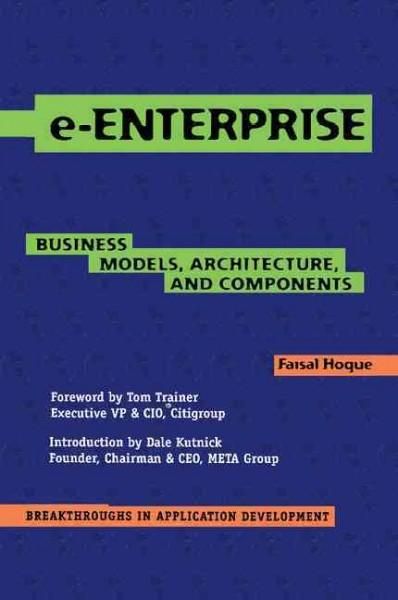E-Enterprise Summary

4 min read ⌚
 Business Models, Architecture, and Components
Business Models, Architecture, and Components
All around you, you hear that you should transform your business into an e-enterprise.
What no one tells you is how.
We are here to tell you that it is not easy. However, that does not mean it is impossible. With the correct approach, you can achieve everything.
Read our “E-Enterprise” summary to learn what the term means, what process you should follow while developing an e-business model and what technology components are most commonly utilized in e-enterprise application development.
Who Should Read “E-Enterprise”? and Why?
Nowadays, all around you people advise you that you should turn your organization into an e-enterprise if you wish for it to survive.
However, although these general recommendations to embrace change are numerous, actual practical advice on how to transform your business is hard to find.
This is the value of Hoque’s “E-Enterprise”. The book discards all basic statements and immediately dives into a clarification of online business models, applications, tools, and architecture.
We recommend this book to managers and executives who want to transform their business. Let’s just note that even this encyclopedic guide, will satisfy even highly knowledgeable readers.
About Faisal Hoque
 During the past decade, Faisal Hoque has worked on Net commerce initiatives with many large businesses. He is the founder of three companies: KnowledgeBase, EC Cubed, and Enamics, where he currently serves as Chairman and CEO.
During the past decade, Faisal Hoque has worked on Net commerce initiatives with many large businesses. He is the founder of three companies: KnowledgeBase, EC Cubed, and Enamics, where he currently serves as Chairman and CEO.
“E-Enterprise Summary”
Net commerce, or the undertaking of all types of activities over the Internet, has developed rapidly, starting from the days of electronic brochure hosting.
There are two stages of Net Commerce, who have created a wide range of new applications and business models.
-
- E-commerce is the first stage of Net Commerce. It involved the creation of B2C services. During this phase, several business models appeared: E-tailing and consumer portals, the consumer bidding and auctioning model, and the electronic bill payment model.
- 2. E-business is the second stage of Net Commerce, which involved the development of business and application models focused on the needs of the B2B marketplace. Example models which appeared during this phase include the B2B procurement and resource management model and the extended value chain model.
Ever since the startup fever has scattered and web-based business and e-business models have started to develop, numerous business leaders try to find out how to turn the potential of e-business and e-commerce into a suitable long-haul strategy.
You have guessed it right: the answer lies in e-enterprise.
Early E-enterprises frequently start as organizations serving both consumer and business clients. Such organizations have found that applications created to help e-commerce and e-business models contain some same building blocks.
However, exploiting the synergy between e-business and e-commerce applications gives just a starting point for developing a practical e-enterprise.
In a well-built e-enterprise, reusability applies to specific application segments, as well as to any bit of information, business process, analysis, technology segment, or application model that may eventually prove useful to some part of the company.
What about interoperability?
It should refer to data access over the whole association and even to industrial partners.
The abbreviated improvement cycle speaks to just a piece of the organizational structure that can address real-time requests on marketing, design, distribution, assembly and customer support.
If you decide to build an e-enterprise, you have to be prepared to make broad-based changes in your company.
Executives must get involved in e-enterprise innovation, and return the technology specialists to their traditional work placements regarding design and implementation.
Furthermore, business models must evolve to include joint strategic efforts with partner associations. Application development must keep up the standards of reusability and interoperability.
Lastly, corporate culture must include an overall perspective of the enterprise as a moving selection of horizontal, frequently inter-company groups, tied down by interior vertical management structures.
Key Lessons from “E-Enterprise”
1. Continuous Development
2. Application and Technology Architecture
3. Business and Technology Components Used in E-Enterprise Application Development
Continuous Development
The core of e-enterprise is the constant development life cycle. Its tightly scheduled development process goes through five stages:
-
- E-visioning / E-strategy
-
- E-process modeling
-
- E-application modeling
-
- E-application architecture
- E-knowledge base development and maintenance
Application and Technology Architecture
To support the continuous development model, e-enterprise application and technology architecture development processes must focus on fostering flexibility and interoperability.
On the technological level, interoperability means creating applications using standard technologies.
On the business level, interoperability requires the usage of open standards.
By adapting to widely utilized standards, e-enterprises can increase their flexibility and the probability of their systems’ integration with those of their partners.
Business and Technology Components Used in E-Enterprise Application Development
These components are best characterized by reusability and flexibility. Almost all Net Commerce initiatives ask for the same business and technology components so that we will list the fundamental ones below.
Business components:
-
- Security and Access Control
-
- User Profiling
-
- Search engine content Management
-
- Catalog Management
-
- Payment
-
- Workflow management
-
- Event Notification
-
- Collaboration
-
- Reporting and Analysis
- Application / Data / Message Integration
Technology Components:
-
- Client Components
-
- Server Components
-
- Application Servers
-
- Application Frameworks
- Enterprise Application Integration (EAI)
Like this summary? We’d Like to invite you to download our free 12 min app, for more amazing summaries and audiobooks.
“E-Enterprise” Quotes
Making the transition from e-Commerce to e-Business to e-Enterprise means understanding and anticipating the changes that must occur in every aspect of the enterprise: culture, people, business model, organizational model, application… Share on X If there’s a bottom-line lesson to everything we know about e-Enterprise, it is this: if you haven’t created business and technology architectures that enable you to win and win again - if they aren’t robust and repeatable in terms of… Share on X Successful e-Enterprise initiatives must include the capability to market, demonstrate, and configure products and services, serve as negotiator and settler of transactions and integrate real-time information from the Net into the existing… Share on X More than anything else, becoming an e-Enterprise is about using the speed, ubiquity, and power of the Net to run the entire organization in real-time. Share on X Interoperability from a technology standpoint means being able to closely integrate with every technology investment that the corporation has made. Share on XOur Critical Review
The book is a great choice for people that run businesses and have some knowledge in the field. Technologically challenged readers, on the other hand, will find it harder to grasp because of its lack of generalities.








